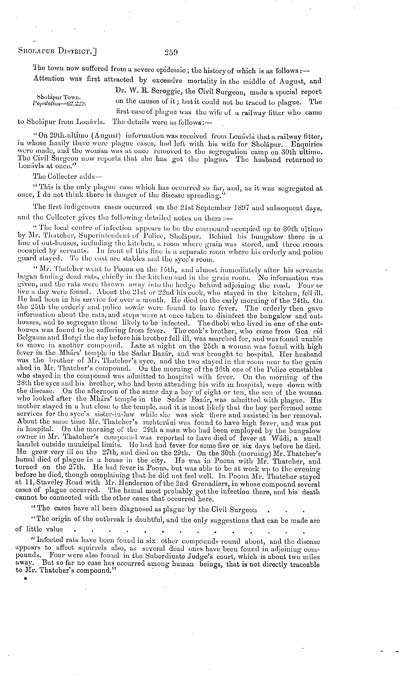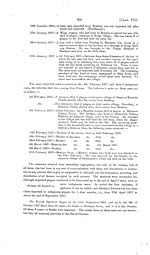Medicine - Disease > Bombay plague: being a history of the progress of plague in the Bombay presidency from September 1896 to June 1899
(333) Page 259
Download files
Individual page:
Thumbnail gallery: Grid view | List view

SHOLAPUR DISTRICT.]
Sholpur Town.
Population-62,229.
The town now suffered from a severe epidemic ; the history o which is as follows :-
Attention was first attracted by excessive mortality in the middle of August, and
Dr. W. R. Scroggie, the Civil Surgeon, made a special report
on the causes of it ; but it could not be traced to plague. The
first case of plague was the wife of a railway utter who came
to Sholpur from Louvia. The details were as follows: -
"On 29th ultimo (August) information was received from Lonvl that a railway fitter,
in whose family there were plague cases, had left with his wife for Sholpur, Enquiries
were made, and the woman was at once removed to the segregation camp on 30th ultimo.
The Civil Surgeon now reports that she has got the plague. The husband returned to
Lonvla at once."
The Collecter adds-
" This is the only plague case which has occurred so far, and, as it was segregated at
once, I do not think there is danger of the disease spreading."
The first indigenous cases occurred on the 21st September 1897 and subsequent days,
and the Collecter gives the following detailed notes on them :-
"The local centre of infection appears to be the compound occupied up to 30th ultimo
by Mr. Thatcher, Superintendent of Police, Sholpur. Behind his bungalow there is a
line of out-houses, including the kitchen, a room where grain was stored, and three rooms
occupied by servants. In front of this line is a separate room where his orderly and police
guard stayed. To the east are stables and the syce's room.
"Mr. Thatcher went to Poona on the 15th, and almost immediately after his servants
began finding dead rats, chiefly in the kitchen and in the grain room. No information was
given, and the rats were thrown away into the hedge behind adjoining the road. Four or
five a day were found. About the 21st or 22nd his cook, who stayed in the kitchen, foll ill.
He had been in bis service for over a, month. He died on the early morning of the 24th. On
the 25th the orderly and police sowr were found to have fever. The orderly then gave
information about the rats, and stops were at once taken to disinfect the bungalow and out-
bouses, and to segregate those likely to be infected. The dhobi who lived in one of the out-
houses was found to be suffering from fever. The cook's brother, who came from Goa vi
"Belgaum and Hotgi the day before bis brother fell ill, was searched for, and was found unable
to move in another compound. Late at night on the 25th a woman was found with high
fever in the Mhrs' temple in the Sadar Bazr, and was brought to hospital. Her husband
was the brother of Mr. Thatcher's syce, and the two stayed in the room near to the grain
shed in Mr. Thatcher's compound. On the morning of the 26th one of the Police constables
who stayed in the compound was admitted to hospital with fever. On the morning of the
28th the syce and bis brother, who had been attending bis wife in hospital, were down with
the disease. On the afternoon of the same day a boy of eight or ten, the son of the woman
who looked after the Mhrs' temple in the Sadar Bazr, was admitted with plague. His
mother stayed in a hut close to the temple, and it is most likely that the boy performed some
services for the syce's sister-iu-law while she was sick there and assisted in lier removal.
About the same time Mr. Thatcher's mehterni was found to have high fever, and was put
in hospital. On the morning of the 29th a man who bad been employed by the bungalow
owner in Mr. Thatcher's compound was reported to have died of fever at Wdi, a small
hamlet outside municipal limits. He bad had fever for some five or six days before he died.
He grew very ill on the 27th, and died on the 29th. On the 30th (morning) Mr. Thatcher's
hamal died of plague in a house in the city. He was in Poona with Mr. Thatcher, and
turned on the 27th. He bad fever in Poona, but was able to be at work up to the evening
before he died, though complaining that he did not feel well. In Poona Mr. Thatcher stayed
at 11, Staveley Road with Mr. Henderson of the 2nd Grenadiers, in whose compound several
cases of plague occurred. The hamal most probably got the infection there, and his death
cannot be connected with the other cases that occurred here.
" The cases have all been diagnosed as plague by the Civil Surgeon
"The origin of the outbreak is doubtful, and the only suggestions that can be made are
of little value
" Infected rats have been found in six other compounds round about, and the disease
appears to affect squirrels also, as several dead ones have been found in adjoining com-
pounds. Four were also found in the Subordinate Judge's court, which is about two miles
away. But so far no case has occurred among human beings, that is not directly traceable
to Mr. Thatcher's compound."
Sholpur Town.
Population-62,229.
The town now suffered from a severe epidemic ; the history o which is as follows :-
Attention was first attracted by excessive mortality in the middle of August, and
Dr. W. R. Scroggie, the Civil Surgeon, made a special report
on the causes of it ; but it could not be traced to plague. The
first case of plague was the wife of a railway utter who came
to Sholpur from Louvia. The details were as follows: -
"On 29th ultimo (August) information was received from Lonvl that a railway fitter,
in whose family there were plague cases, had left with his wife for Sholpur, Enquiries
were made, and the woman was at once removed to the segregation camp on 30th ultimo.
The Civil Surgeon now reports that she has got the plague. The husband returned to
Lonvla at once."
The Collecter adds-
" This is the only plague case which has occurred so far, and, as it was segregated at
once, I do not think there is danger of the disease spreading."
The first indigenous cases occurred on the 21st September 1897 and subsequent days,
and the Collecter gives the following detailed notes on them :-
"The local centre of infection appears to be the compound occupied up to 30th ultimo
by Mr. Thatcher, Superintendent of Police, Sholpur. Behind his bungalow there is a
line of out-houses, including the kitchen, a room where grain was stored, and three rooms
occupied by servants. In front of this line is a separate room where his orderly and police
guard stayed. To the east are stables and the syce's room.
"Mr. Thatcher went to Poona on the 15th, and almost immediately after his servants
began finding dead rats, chiefly in the kitchen and in the grain room. No information was
given, and the rats were thrown away into the hedge behind adjoining the road. Four or
five a day were found. About the 21st or 22nd his cook, who stayed in the kitchen, foll ill.
He had been in bis service for over a, month. He died on the early morning of the 24th. On
the 25th the orderly and police sowr were found to have fever. The orderly then gave
information about the rats, and stops were at once taken to disinfect the bungalow and out-
bouses, and to segregate those likely to be infected. The dhobi who lived in one of the out-
houses was found to be suffering from fever. The cook's brother, who came from Goa vi
"Belgaum and Hotgi the day before bis brother fell ill, was searched for, and was found unable
to move in another compound. Late at night on the 25th a woman was found with high
fever in the Mhrs' temple in the Sadar Bazr, and was brought to hospital. Her husband
was the brother of Mr. Thatcher's syce, and the two stayed in the room near to the grain
shed in Mr. Thatcher's compound. On the morning of the 26th one of the Police constables
who stayed in the compound was admitted to hospital with fever. On the morning of the
28th the syce and bis brother, who had been attending bis wife in hospital, were down with
the disease. On the afternoon of the same day a boy of eight or ten, the son of the woman
who looked after the Mhrs' temple in the Sadar Bazr, was admitted with plague. His
mother stayed in a hut close to the temple, and it is most likely that the boy performed some
services for the syce's sister-iu-law while she was sick there and assisted in lier removal.
About the same time Mr. Thatcher's mehterni was found to have high fever, and was put
in hospital. On the morning of the 29th a man who bad been employed by the bungalow
owner in Mr. Thatcher's compound was reported to have died of fever at Wdi, a small
hamlet outside municipal limits. He bad had fever for some five or six days before he died.
He grew very ill on the 27th, and died on the 29th. On the 30th (morning) Mr. Thatcher's
hamal died of plague in a house in the city. He was in Poona with Mr. Thatcher, and
turned on the 27th. He bad fever in Poona, but was able to be at work up to the evening
before he died, though complaining that he did not feel well. In Poona Mr. Thatcher stayed
at 11, Staveley Road with Mr. Henderson of the 2nd Grenadiers, in whose compound several
cases of plague occurred. The hamal most probably got the infection there, and his death
cannot be connected with the other cases that occurred here.
" The cases have all been diagnosed as plague by the Civil Surgeon
"The origin of the outbreak is doubtful, and the only suggestions that can be made are
of little value
" Infected rats have been found in six other compounds round about, and the disease
appears to affect squirrels also, as several dead ones have been found in adjoining com-
pounds. Four were also found in the Subordinate Judge's court, which is about two miles
away. But so far no case has occurred among human beings, that is not directly traceable
to Mr. Thatcher's compound."
Set display mode to: Large image | Zoom image | Transcription
Images and transcriptions on this page, including medium image downloads, may be used under the Creative Commons Attribution 4.0 International Licence unless otherwise stated. ![]()
| India Papers > Medicine - Disease > Bombay plague: being a history of the progress of plague in the Bombay presidency from September 1896 to June 1899 > (333) Page 259 |
|---|
| Permanent URL | https://digital.nls.uk/74586634 |
|---|




